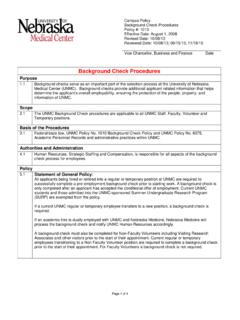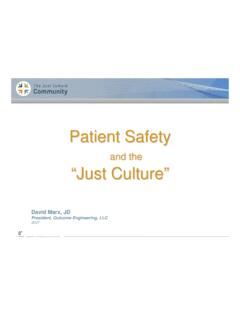Transcription of Recommendations and Guidelines for Preoperative …
1 Recommendations and Guidelines for Preoperative Evaluation of the Surgical Patient with Emphasis on the Cardiac Patient for Non-cardiac Surgery Recommendations and Guidelines For Preoperative Evaluation Of the Surgical Patient With Emphasis on the Cardiac Patient For Non-cardiac Surgery John H. Tinker, Professor and Chair Anesthesiology Department university of nebraska medical center Richard R. Miles, Myrna C. Newland, Associate Professor and Associate Professor Chief, Section of Cardiology Anesthesiology Barbara J. Hurlbert, Professor, Anesthesiology medical Director, Anesthesia Preoperative Evaluation Unit Barbara J.
2 Sink, MPAS, PA-C. Anesthesia Preoperative Evaluation Unit Kathi M. Healey, , Nurse Practitioner Clinical Director, Lipid clinic Stephen J. Froscheiser, Computing Support Bill Wassom, Graphic Designer university of nebraska medical center 2006. 1. Preoperative preparation of the patient for non-cardiac surgery may be complex. The variety of presenting conditions may be difficult to define prior to surgery: What tests should be ordered? When is a long-standing condition in satisfactory control, or should some additional study or medication be added prior to operation? What are the risks of anesthesia and of the operation for the patient?
3 The following collection of information from many sources is designed to be a quick reference for anyone who is involved in the preparation of the patient for non-cardiac surgery. These are proposed Guidelines and in no way should supersede good clinical evaluation and assessment. The following information has been reviewed by Richard R. Miles, , Cardiology; Myrna C. Newland, , Anesthesiology; B. Timothy Baxter, , Vascular Surgery; and Frank O. Hayworth, , Anesthesiology. Compilation of the following references was through the efforts of Barbara J. Sink, PA-C, Anesthesia Preoperative Evaluation Unit; Kathi M.
4 Healey, , , Cardiology; and computing support from Stephen J. Froscheiser, , Anesthesia Preoperative Evaluation Unit. Myrna C. Newland, Associate Professor Anesthesiology university of nebraska medical center 2. Table of Contents Classification Conditions for Preoperative Evaluation .. 4. Preoperative Algorithm .. 6. Surgical Classification .. 7. ASA Classification .. 11. Cardiovascular Cardiovascular Evaluation Guidelines .. 12. Vascular Surgery Addendum .. 17. Preoperative Physical Exam .. 18. Cardiac Murmurs .. 20. Reading an EKG .. 25. NYHA Classification of CHF. Pathology-Unstable Angina.
5 32. Syndromes with Associated Cardiovascular Involvement .. 35. Down's Syndrome .. 38. Antihypertensive Therapy .. 39. Pheochromocytoma .. 40. Ischemic Heart Disease .. 42. Echocardiography .. 46. Prophylaxis Guidelines for Endocarditis .. 48. Anesthesia Cardiac Risk Stratification .. 54. Difficult Airway Algorithm .. 57. (Note also: Down's Syndrome, 30). States That Influence Airway Management .. 58. NPO Status for Surgical Patients .. 61. Pulmonary Function Tests .. 62. The Assessment of Dyspnea .. 64. Labs Preoperative Test Recommendation Guidelines .. 65. Patient Charges: Inpatient/Outpatient.
6 66. Information for Blood Typing .. 69. Normal Lab Ranges .. 70. Medications/Chemotherapy Medications to Be Avoided Prior to Surgery .. 72. Drug Allergy vs . Drug Intolerance .. 74. Chemotherapy/Toxicity .. 76. Blood Product Risks .. 79. General Information Telephone Number List .. 80. Reference Chart .. 81. 3. Conditions for Which Preoperative Evaluation Is Strongly Recommended Prior to the Day of Surgery General medical condition inhibiting ability to engage in normal daily activity medical conditions necessitating continual assistance or monitoring at home within the past 6 months Admission within the past 2 months for acute or exacerbation of chronic condition Cardiocirculatory History of angina, coronary artery disease, myocardial infarction Symptomatic arrhythmias Poorly controlled hypertension (diastolic >110, systolic >160).
7 History of congestive heart failure Respiratory Asthma/COPD requiring chronic medication or with acute exacerbation and progression within past 6 months History of major and/or lower airway tumor or obstruction Upper and/or lower airway tumor or obstruction History of chronic respiratory distress requiring home ventilator assis- tance or monitoring Endocrine Non-diet controlled diabetes (insulin or oral hypoglycemic agents). Adrenal disorders Active thyroid disease Neuromuscular History of seizure disorder or other significant CNS disease ( , mul- tiple sclerosis). History of myopathy or other muscle disorders Hepatic Any active hepatobiliary disease or compromise 4.
8 Musculoskeletal Kyphosis and/or scoliosis causing functional compromise Temporomandibular joint disorder Cervical or thoracic spine injury Oncology Patients receiving chemotherapy Other oncology process with significant physiologic residual or compro- mise Gastrointestinal Massive obesity (>140% ideal body weight). Hiatal hernia Symptomatic gastroesophageal reflex Clinical Anesthesia Updates. Preanesthesia Evaluation of the Surgical Pa- tient, vol. 6, #2, p. 5. L. Reuven Pasternak, , 5. Preoperative Evaluation by Primary Team Determine: ASA status (table 9-3). surgery classification ASA 1 ASA 2-4.
9 Order appropriate order appropriate labs, CXR, EKG labs, CXR, EKG. (per table ) (per table ). Normal abnormal abnormal findings normal findings findings findings other than correctable PTC visit PTC visit labs ( refer to ASA #2. schedule in schedule pt. in LABS CXR EKG. Correctable labs labs requiring normal w/ abnormal normal abnormal or (or normal) further work-up no other abnormal findings ( consult) abnormalities CT or Pulmonary on cardiac exam consult as indicated Corrected w/no appropriate PTC visit refer to algothithm further abnormalities follow up w/ appropiate (10-2).)
10 Corrections Schedule in follow up *PTC visit where needed completed cardiology if no consult consult required required *PTC visit *PTC visit schedule in pt. cleared further follow *PTC visit schedule in for surgery up by cardiology required prior schedule pt. *PTC visit to scheduling pt. in for surgery * PT SHOULD BRING H&P, CHART, scheduled pt. SURGICAL CONSENT, BLOOD CONSENT in AND ORDERS WITH THEM TO THE weight limit PFT'S: intrathoracic or extrathoracic mass Bedside PFT'S: thoracic procedure or major abdominal ABG'S: suspected CO2 retainer 300 lbs lobectomy w/ possible pneumoetomy.









